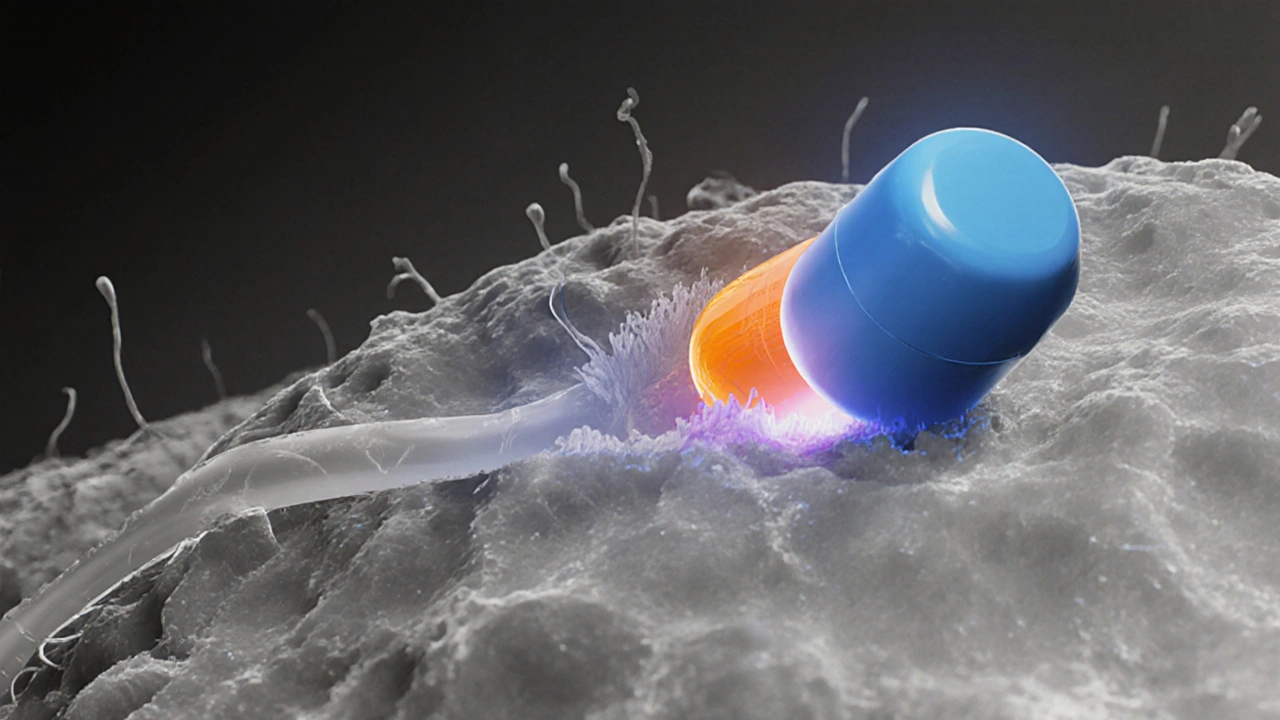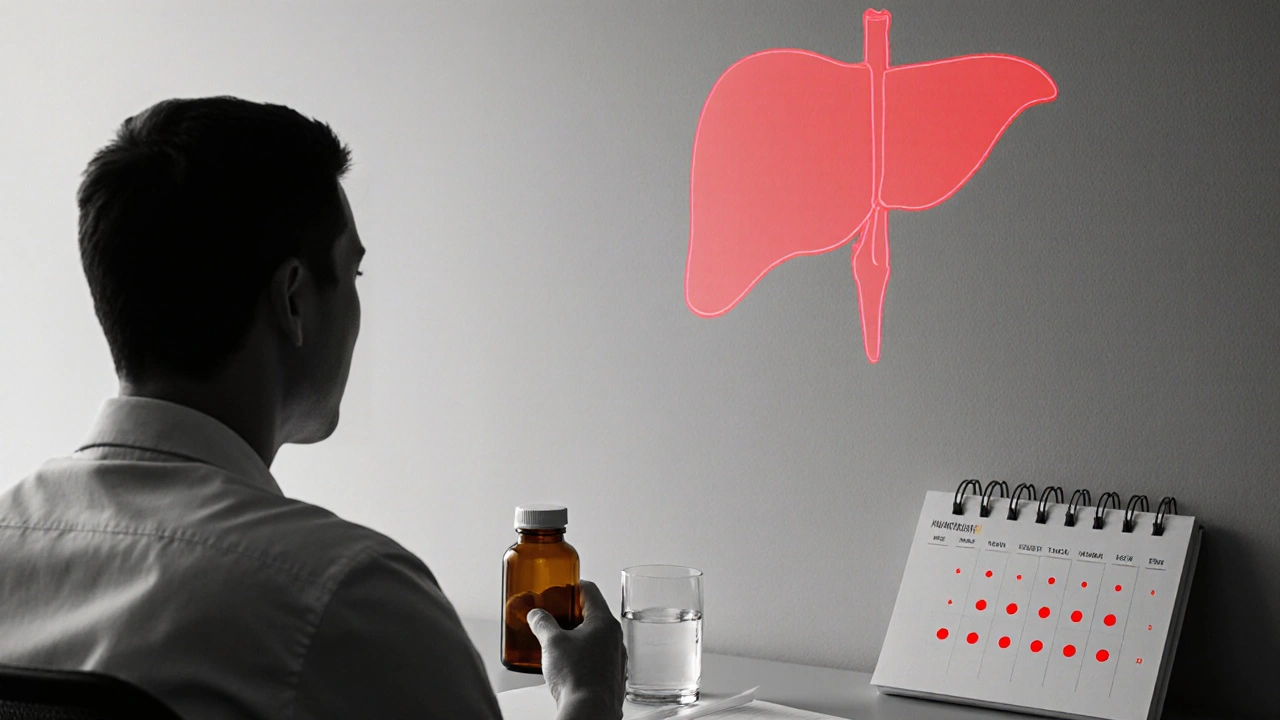Tolvaptan Medication Interaction Checker
This tool helps identify potential drug interactions between tolvaptan and other medications. Tolvaptan is metabolized primarily by CYP3A4, so interactions with inhibitors or inducers of this enzyme can significantly affect its safety and efficacy.
No medications selected yet. Start typing to search for medications.
Interaction Results
Ever wondered why a drug that sounds like a tongue‑twister can slow kidney cyst growth? tolvaptan does exactly that, but the science behind it isn’t magic-it’s solid pharmacology. This article walks you through how the molecule works, who benefits, and what clinicians need to watch for.
What is Tolvaptan?
Tolvaptan is a selective vasopressin V2‑receptor antagonist approved for treating autosomal dominant polycystic kidney disease (ADPKD). It was first approved by the FDA in 2012 and later received EMA endorsement in 2015. The drug comes in 45mg and 90mg oral tablets, designed for once‑daily dosing after a careful titration period.
Mechanism of Action: Blocking Vasopressin V2 Receptors
To understand tolvaptan, you need to meet its main partner: the vasopressin V2 receptor.
Vasopressin V2 receptor is a G‑protein‑coupled receptor located primarily in the renal collecting duct. When antidiuretic hormone (vasopressin) binds, it triggers cAMP production, which in turn drives water reabsorption via aquaporin‑2 channels.
In ADPKD, high circulating vasopressin continuously pushes the V2 receptor, causing cyst‑lining cells to proliferate and secrete fluid. Tolvaptan competes with vasopressin for the V2 binding site, effectively turning the signal off. The result is reduced cAMP, slower cyst growth, and a modest decline in total kidney volume.
Pharmacokinetics: How the Body Handles Tolvaptan
After a fasted oral dose, tolvaptan reaches peak plasma concentrations (Cmax) in 2-4hours. Its absolute bioavailability hovers around 56%, and food can cut Cmax by up to 50%, so clinicians advise taking the drug with a light snack at most.
Metabolism is almost exclusive to CYP3A4, the hepatic enzyme that also processes many antihypertensives and antifungals. Because of this, strong CYP3A4 inducers (e.g., rifampin) slash tolvaptan exposure, while inhibitors (e.g., ketoconazole) can double it. The drug’s half‑life is roughly 12hours, supporting once‑daily dosing after the titration phase.
Excretion is primarily biliary; less than 1% of the dose appears unchanged in urine. This makes renal impairment a less critical factor for clearance, but liver function becomes the monitoring focus.

Clinical Use: Targeting Autosomal Dominant Polycystic Kidney Disease (ADPKD)
ADPKD is a genetic disorder characterized by the formation of numerous fluid‑filled cysts in both kidneys, leading to progressive loss of renal function. It accounts for about 5% of end‑stage renal disease cases worldwide.
The pivotal TEMPO3:4 trial enrolled 1,445 patients with eGFR≥60ml/min/1.73m². Over a 3‑year period, tolvaptan reduced the annual increase in total kidney volume by 49% and slowed the decline in eGFR by 1.2ml/min/1.73m² compared with placebo. These numbers translate into a delayed need for dialysis or transplantation by roughly 5-7years for many patients.
Guidelines from KDIGO (2023) recommend tolvaptan for individuals with rapidly progressing ADPKD, defined by a historical eGFR decline >5ml/min/1.73m² over 5years or a Mayo imaging classification of 1C‑1E.
Dosing and Administration: Step‑by‑Step Titration
- Start with 45mg once daily (morning) for 14days.
- If tolerated, increase to 90mg once daily for another 14days.
- After steady-state is reached, the maintenance dose can be split: 45mg in the morning and 45mg in the afternoon, totaling 90mg per day.
- For patients with high hepatic risk, consider a lower maintenance dose (45mg total) with stricter liver‑function monitoring.
Because food can blunt absorption, advise patients to take the dose with a light snack (e.g., a piece of toast) rather than a full meal.
Safety Profile: What to Watch For
The most serious concern is hepatotoxicity. In clinical trials, 4% of participants experienced elevated ALT/AST levels >3× upper limit of normal, prompting early discontinuation. Current recommendations call for liver‑function tests (ALT, AST, bilirubin) at baseline, then monthly for the first 18months, and quarterly thereafter.
Common side effects include:
- Polyuria and nocturia - a direct result of aquaretic action.
- Thirst and dry mouth - patients often increase water intake to avoid dehydration.
- Elevated serum uric acid - gout prophylaxis may be needed for susceptible individuals.
Rarely, patients report severe hypersensitivity reactions. If any rash, fever, or jaundice appears, stop the drug immediately and evaluate liver enzymes.

How Tolvaptan Stacks Up Against Other V2 Antagonists
| Attribute | Tolvaptan | Lixivaptan (investigational) | Placebo |
|---|---|---|---|
| FDA Approval | Yes (2012) | Pending | N/A |
| Primary Metabolism | CYP3A4 | CYP3A4 & CYP2C9 | N/A |
| Half‑life | ≈12h | ≈8h | N/A |
| Effect on Total Kidney Volume (3yr) | ‑49% | ‑36% (phase2) | ‑0% |
| Hepatotoxicity ≥3× ULN | 4% | 1.5% | 0% |
While lixivaptan shows promise with a slightly shorter half‑life and lower liver‑enzyme spikes, tolvaptan remains the only agent with long‑term outcome data and regulatory approval.
Practical Tips for Clinicians and Patients
- Screen for baseline liver disease - hepatitis B/C, cirrhosis, or elevated baseline ALT/AST are contraindications.
- Educate patients about the inevitable increase in urine output; suggest timed bathroom breaks to improve adherence.
- Check for drug‑drug interactions, especially with strong CYP3A4 inhibitors (antifungals, macrolides) or inducers (carbamazepine, phenytoin).
- Maintain a hydration log - patients who drink >2L/day tend to tolerate the aquaretic effect better.
- Consider a low‑dose aspirin regimen if the patient has high cardiovascular risk; tolvaptan itself does not affect platelet function.
By integrating these safeguards, the benefits of slowed kidney decline usually outweigh the manageable risks.
Frequently Asked Questions
How long does it take for Tolvaptan to show kidney‑size reduction?
Significant reductions in total kidney volume appear after 6‑12months of consistent therapy, as seen in the TEMPO3:4 trial’s interim analyses.
Can Tolvaptan be used in patients with already impaired liver function?
No. Current guidelines contraindicate use in patients with ALT/AST >1.5× ULN or known cirrhosis because the drug’s hepatotoxic potential becomes unpredictable.
What monitoring schedule is recommended for liver enzymes?
Baseline, then monthly for the first 18months, followed by quarterly checks. Any rise >3× ULN warrants immediate dose hold and repeat testing.
Is it safe to take Tolvaptan with common blood‑pressure meds?
Generally yes, but avoid concurrent strong CYP3A4 inhibitors (e.g., itraconazole) that can raise tolvaptan levels and increase side‑effect risk.
Will Tolvaptan cure ADPKD?
No. It slows disease progression, buying years of kidney function, but it does not eliminate cyst formation or reverse existing damage.

16 Responses
Interesting overview of how tolvaptan works.
The article reads like a textbook copy‑paste, glossing over the gritty reality of managing ADPKD patients. While the mechanism is explained, it sidesteps the economic burden and the sheer inconvenience of polyuria that most patients despise. A deeper dive into real‑world adherence issues would have made this piece more than a sterile summary.
Just a heads‑up: the piece mentions “CYP3A4” twice in the same paragraph without a transition, which reads a bit clunky. Also, “elevated ALT/AST levels >3× upper limit of normal” could be phrased more precisely as “greater than three times the upper limit of normal.” Otherwise, solid content.
Oh great, another miracle pill that makes you pee like a faucet. Who needs a normal night’s sleep when you can watch the toilet clock tick past 3 a.m.? Jokes aside, the data does show a measurable slowdown in cyst growth, so there’s some merit behind the hype.
I’ve seen a handful of patients struggle with the water‑intake demands, but when the liver‑function monitoring is done right, the trade‑off can be worthwhile. The key is setting realistic expectations early on – tell them they’ll be hitting the bathroom more often, and that’s part of the therapeutic effect. By coupling education with a hydration schedule, adherence improves dramatically.
Frankly, anyone who balks at the side‑effects is just looking for an easy fix. ADPKD is a relentless disease, and tolerating polyuria is a small price to pay for preserving kidney function for a few extra years. If patients can’t handle that, perhaps they’re not ready for the responsibility of managing a chronic condition.
Exactly, Mark. The study you referenced also highlighted that monthly liver panels caught 85% of elevations before they became clinically significant. Consistent follow‑up is non‑negotiable; it’s the safety net that keeps the regimen viable.
Yo, Sonia, love the vibe 😎. Real‑world adherence is definitely a beast, but the community forums have some killer hacks for managing the nocturia – like setting a “bathroom alarm” to limit trips. Sharing those tips could make the article feel less like a lecture.
From an Indian perspective, the cost barrier of tolvaptan is a gigantic hurdle that the article completely overlooks. The pharmacoeconomic models used in Western trials don’t translate to our public‑health system, where out‑of‑pocket expenses can cripple access for the majority of ADPKD families.
The piece could have used a more concise structure; paragraph three drags on with redundant clauses. Also, “the drug’s half‑life is roughly 12hours” should read “approximately 12 hours” for consistency with scientific style.
Reading through the article reminded me just how far we’ve come in managing a disease that once seemed hopeless. First, the clear explanation of V2‑receptor antagonism gave a solid foundation for anyone new to the topic. Second, the inclusion of real‑world dosing schedules demystifies the titration process, which many patients find intimidating. Third, the safety section appropriately emphasizes liver monitoring, a critical step that can’t be overstated. Fourth, the discussion of polyuria acknowledges the quality‑of‑life impact, encouraging clinicians to counsel patients proactively. Fifth, the comparative table of V2 antagonists offers a quick visual cue that helps in shared decision‑making. Sixth, highlighting the TEMPO3:4 trial’s outcomes provides evidence‑based reassurance of efficacy. Seventh, the practical tips for hydration logs and timed bathroom breaks are pearls that translate directly into practice. Eighth, the mention of contraindications such as pre‑existing liver disease protects vulnerable groups. Ninth, the article’s balanced tone avoids hype while still celebrating the drug’s benefits. Tenth, by addressing drug‑drug interactions, it equips prescribers to avoid dangerous combinations. Eleventh, the FAQ section anticipates common patient concerns, saving clinic time. Twelfth, the call for diligent liver enzyme checks underscores a proactive safety culture. Thirteenth, the piece subtly reminds us that while tolvaptan slows progression, lifestyle modifications remain essential. Fourteenth, the acknowledgment of the drug’s limitations keeps expectations realistic. Finally, the overall structure-from mechanism to practical advice-makes this a valuable resource for both nephrologists and the patients they serve.
🙌 Absolutely love the comprehensive breakdown, Patricia! The “practical tips” segment especially hits the sweet spot for bridging theory and bedside care. Those hydration logs can be a game‑changer for patients dealing with aquaresis.
Data shows tolvaptan reduces TKV growth by nearly half over three years.
Indeed, the numbers are striking; however, one must consider the broader context, such as regional healthcare infrastructure, patient education levels, and socioeconomic factors, all of which can influence real‑world outcomes; therefore, while the trial data is promising, implementation strategies must be tailored accordingly.
From a philosophical standpoint, the pursuit of slowing an inexorable disease like ADPKD raises profound questions about the value we place on extending life versus preserving its quality. We must ask whether the relentless focus on biomarkers, such as total kidney volume, eclipses the lived experience of patients coping with frequent bathroom runs and anxiety over liver tests. Yet, the very act of intervening, even in a modest way, can restore a sense of agency to individuals who otherwise feel at the mercy of genetics. It’s a delicate balance between scientific ambition and humane compassion, and any therapeutic strategy should honor both.
Jenny, you’ve raised an insightful point about agency – perhaps incorporating patient‑reported outcome measures in future trials could better capture that dimension.